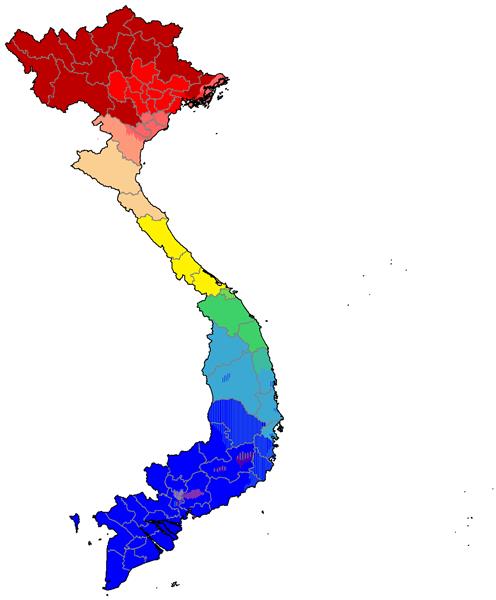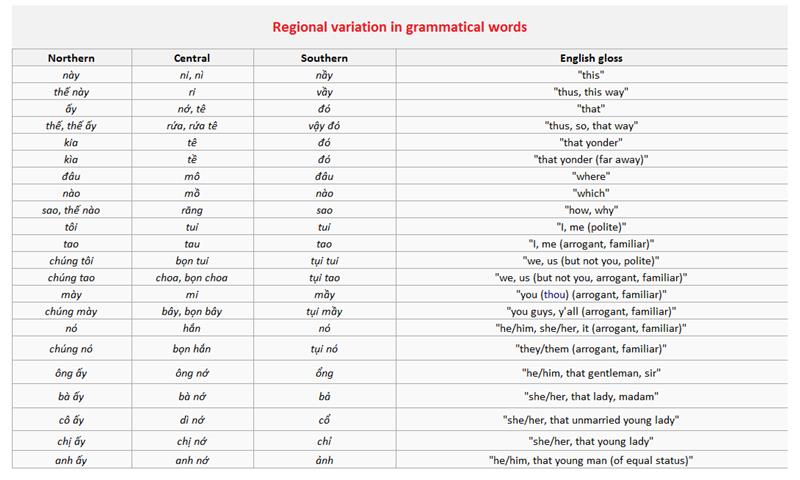There are five main mutually intelligible dialects existing in Vietnam language. They are Northern Vietnamese, North – central Vietnamese, Mid – Central Vietnamese, South – Central Vietnamese, and South Vietnamese. The Northern Vietnamese is spoken popularly in Hanoi, Haiphong, Red River Delta, northwestern, and northeastern areas. The North – central Vietnamese was formed in Thanh Hoa Nghe An, and Ha Tinh. They have their own way in communicating, which is not similar to other regions. While, the Mid – Central Vietnam is used much in Quang Binh, Quang Tri, Hue, and Thua Thien. Da Nang, Quang Nam, Quang Ngai, Binh Dinh, and Phu Yen are the places where South-Central Vietnamese are spoken most. In such places as Nha Trang, Ba Ria-Vung Tau, Saigon, Lam Dong, and Mekong Delta, people speak Southern Vietnamese.
Vietnamese language used to be divided into three regional dialects including North, Central, and South. However, some other linguists offer evidences for dividing North-Central region from Central language region and varieties. This makes the differences in vocabulary, especially between northern and southern. In addition, there is less mutual understanding to Northern, Central and Southern speakers. Less internal variation happens less in Southern Vietnamese speakers, due to the regional variation has been preserved in each region, especially in Northern Vietnam. Along the coastal areas, the regional variation has been counteracted to a certain context.

Beginning in the mid-20th century, there was a large movements of people between North and South, and continuing to present, which triggered a sizeable number of Southern residents speaking in the Northern dialect and, to a greater extent, Northern residents speaking in the Southern dialect. According to the Geneva Accords of 1954, the temporary division of the country was conducted, about a million northern people (mainly from Hanoi, Haiphong and the surrounding Red River Delta areas) moved south (mainly to Saigon and heavily to Bien Hoa and Vung Tau, and the surrounding areas). About 3% (~30,000) of that number of people made the move in the reverse direction.
After the reunification of Vietnam in 1975 - 1976, Northern and North-Central speakers from the densely populated Red River Delta and the traditionally poorer provinces of Nghe An, Ha Tinh and Quang Binh have continued to move South to look for better economic opportunities. They began with the Hanoi government's “New Economic Zones program” which lasted for 10 years (1975-1985). The first half of the program (1975–80), resulted in 1.3 million people sent to the New Economic Zones (NEZs). The majority of which were relocated in the southern half of the country in previously uninhabited areas, of which 550,000 were Northerners. The second half (1981–85) saw almost 1 million Northerners relocated to the NEZs. As well, government and military personnel, many from Northern and north-central Vietnam, are posted to various locations throughout the country, often away from their home regions. More recently, the growth of the free market system has resulted in business people and tourists traveling to distant parts of Vietnam. These movements have resulted in some small blending of the Vietnamese dialects, but more significantly, have made the Northern dialect more easily understood in the South and vice versa. Most Southerners, when singing modern/popular Vietnamese songs, do so in the Northern accent. This is true in Vietnam as well as in the overseas Vietnamese communities.

